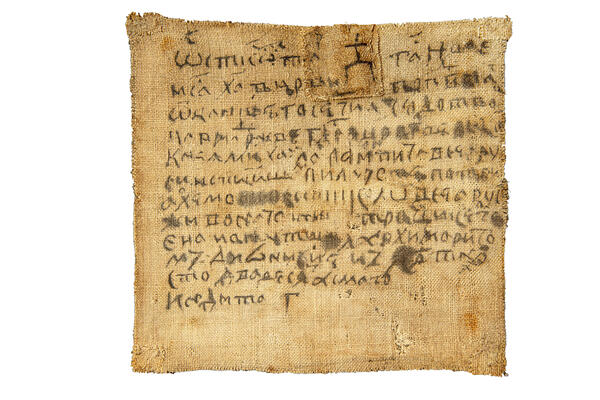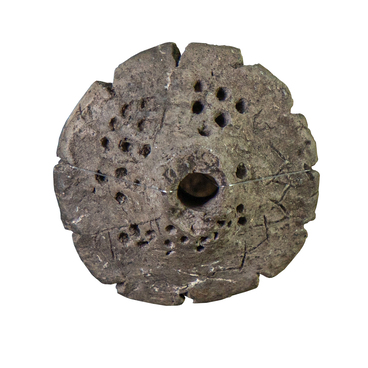The antimensium is a rectangular piece of linen (“plat”) on which the Divine Liturgy is celebrated. It is consecrated and signed by the Bishop. The Divine Liturgy is the main Christian service, during which the Sacrament of the Eucharist takes place. The Eucharist is the consecration of bread and wine in a special way for communion, when believers consume them as a symbol of the flesh and blood of Jesus Christ.
The Antimensium of 1619 is a rare document related to the Holy Trinity-St. Sergius Monastery and the history of the country. It was intended for the consecration of the wooden church of St. Sergius in the village of Deulino, which was erected in honor of the conclusion of the truce “between… the Moscow and Polish states” for the period of 14.5 years.
The inscription on the antimensium informs that it was granted “during the reign” of Tsar Mikhail Fedorovich, under Patriarch Filaret (Romanov) by Archimandrite of the Trinity-St. Sergius Monastery Dionysius (Zobninovsky).
Then, in 1618, the army of the Polish prince Vladislav approached the monastery, but the siege of the fortress did not happen. Exhausted by the war, the troops began to look for ways to conclude a truce. The village of Deulino, not far from the monastery, was chosen as the place to negotiate it. The armistice agreement concluded on December 1, 1618, ended the war, which lasted several years. The Deulino truce was not easy for Russia because it was to lose cities such as Smolensk, Roslavl, Putivl, Novgorod-Seversky, Chernigov and others. But at the same time, the truce marked the abandonment of the Polish-Lithuanian Commonwealth to continue the military invasion of Russia and the end of the long-term Time of Troubles in the Russian state.
A wooden church in the name of St. Sergius of Radonezh was erected at the place where the agreement was signed. The church was “cold”, that is, not heated, so in 1849 its priest turned to the Established Council of Lavra with a request extend it with a “warm” chapel to be used for services in the wintertime. During the inspection of the church, this antimensium was found in the altar under the holy table in a small tin reliquary.
Metropolitan Filaret of Moscow, fearing that “this ancient venerable relic would not be deliberately lost, ” ordered it to be transferred to the Lavra for storage with memorial items of St. Sergius and Nikon of Radonezh. The ancient church as a “monument of peace and deliverance of the fatherland from enemies and troubles” was ordered to be preserved without rebuilding, but later it burned down anyway. And a stone warm church was erected nearby in the name of the Image of the All-Merciful Saviour “Not-Made-By-Hands”, which stands in the village today
The Antimensium of 1619 is a rare document related to the Holy Trinity-St. Sergius Monastery and the history of the country. It was intended for the consecration of the wooden church of St. Sergius in the village of Deulino, which was erected in honor of the conclusion of the truce “between… the Moscow and Polish states” for the period of 14.5 years.
The inscription on the antimensium informs that it was granted “during the reign” of Tsar Mikhail Fedorovich, under Patriarch Filaret (Romanov) by Archimandrite of the Trinity-St. Sergius Monastery Dionysius (Zobninovsky).
Then, in 1618, the army of the Polish prince Vladislav approached the monastery, but the siege of the fortress did not happen. Exhausted by the war, the troops began to look for ways to conclude a truce. The village of Deulino, not far from the monastery, was chosen as the place to negotiate it. The armistice agreement concluded on December 1, 1618, ended the war, which lasted several years. The Deulino truce was not easy for Russia because it was to lose cities such as Smolensk, Roslavl, Putivl, Novgorod-Seversky, Chernigov and others. But at the same time, the truce marked the abandonment of the Polish-Lithuanian Commonwealth to continue the military invasion of Russia and the end of the long-term Time of Troubles in the Russian state.
A wooden church in the name of St. Sergius of Radonezh was erected at the place where the agreement was signed. The church was “cold”, that is, not heated, so in 1849 its priest turned to the Established Council of Lavra with a request extend it with a “warm” chapel to be used for services in the wintertime. During the inspection of the church, this antimensium was found in the altar under the holy table in a small tin reliquary.
Metropolitan Filaret of Moscow, fearing that “this ancient venerable relic would not be deliberately lost, ” ordered it to be transferred to the Lavra for storage with memorial items of St. Sergius and Nikon of Radonezh. The ancient church as a “monument of peace and deliverance of the fatherland from enemies and troubles” was ordered to be preserved without rebuilding, but later it burned down anyway. And a stone warm church was erected nearby in the name of the Image of the All-Merciful Saviour “Not-Made-By-Hands”, which stands in the village today


